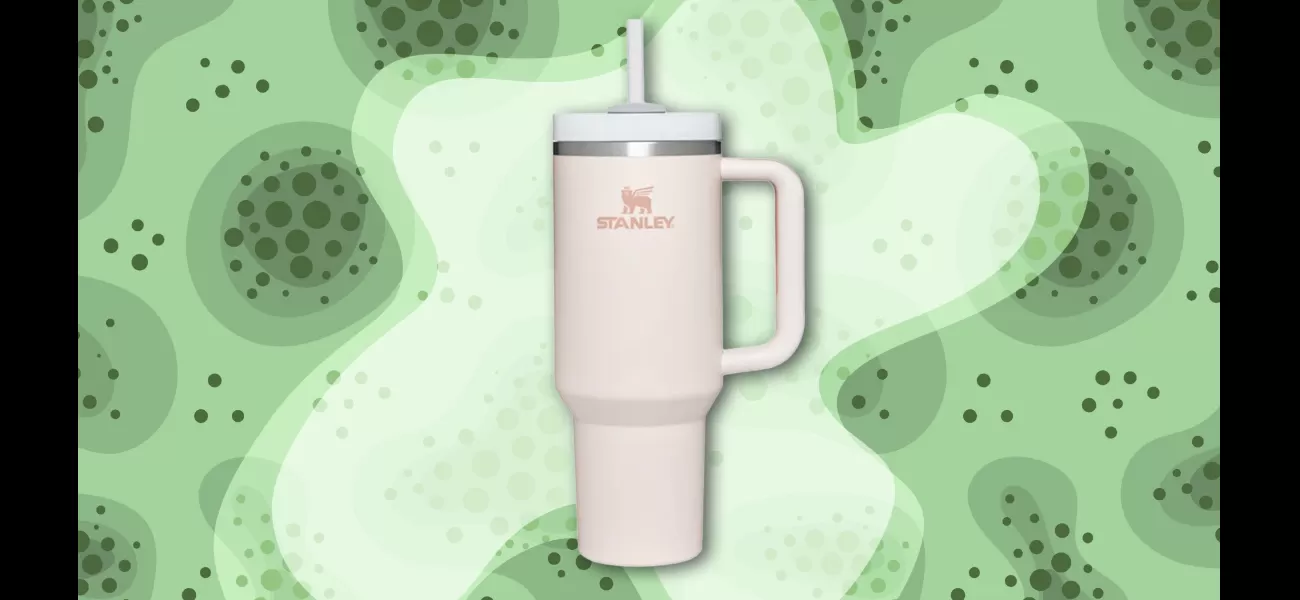The Stanley cup likely has some gross bacteria on it.
Reusable bottles filled with bacteria can cause health problems.
January 18th 2024.

Reusable water bottles, like the popular Stanley cups, have been all the rage lately. They have become a must-have item, especially during the 2023 Christmas season, with people going crazy over these large vacuum insulated tumblers. In fact, Stanley's profits have skyrocketed from $70 million annually to an impressive $750 million last year. These cups have taken over social media platforms like TikTok and have become the "it" product of the moment.
But hold on, before you jump on the Stanley cup bandwagon, there's some unsettling news. A recent study has revealed that these reusable water bottles are more than just a trendy fashion statement. They could potentially make you sick. The study found that the average reusable bottle contains a shocking 40,000 times more bacteria than a toilet seat and 14 times more than a pet bowl. Even more alarming, a quarter of people admitted to only washing their water bottles a few times a week, and 13% only clean them a few times a month.
The amount and type of bacteria found on your Stanley cup depends on how often you wash it and what it comes in contact with. In some cases, these bacteria can be harmful to your health. Dr. Chandni Rajani, a GP and advanced aesthetics doctor, explains, "Common contaminants include bacteria, fungi, and viruses. These germs can cause health issues ranging from gastrointestinal problems to infections, depending on the type and amount present." The study also found that bottles with straw lids were particularly susceptible to bacteria, including gram-negative and bacillus bacteria, which can lead to infections and gastrointestinal issues.
So, how do these bacteria end up on your water bottle? According to GP Dr. Roger Henderson, it all boils down to personal hygiene. "Usually, the bacteria arises from the bottle being handled, so if you haven't washed your hands before filling it up, or touch your face then fill it, you can spread bacteria to the bottle," he explains. This is why it's crucial not to share your reusable bottle or tumbler and to make sure you wash it properly each day. Dr. Henderson also recommends washing your hands before using or filling your cup to reduce the spread of germs.
But here's the catch - simply rinsing your bottle with hot water won't do the trick. Dominic Ponniah, CEO and co-founder of commercial cleaning firm Cleanology, warns that bacteria can hide in unexpected places, such as under the seal, closure, and inside the straw, making it challenging to clean thoroughly. He states, "Black mould, scientifically known as Stachybotrys Chartarum, can grow under the rubber seal of cups. Prolonged drinking of cups that store hidden mould, especially by individuals with asthma or allergies, may result in illness and worsening asthma symptoms." To effectively clean your Stanley cup, he recommends taking it apart and placing all the pieces in the dishwasher or cleaning them with hot soapy water. Allow all components to dry thoroughly before reassembling to prevent bacteria from growing in the warm, damp environment.
But let's be realistic, taking apart and washing your cup every day may not be feasible. In that case, at least make sure to rinse it out regularly and avoid leaving drinks in there for too long. Dr. Rajani also suggests using a dedicated brush or sponge for cleaning, avoiding abrasive materials, and regularly checking for signs of wear or damage. These simple practices not only protect your health but also ensure that your cup remains clean and enjoyable to use.
The Agency has reached out to the makers of Stanley cups for comment and will update this article when we receive a response. Do you have a similar experience to share? We would love to hear from you. Get in touch by emailing us. And while we're on the topic of cleanliness, an extreme cleaner recently shared the worst fridge she has ever seen. Plus, according to a scientist, smartwatch owners could be in contact with pneumonia-causing bacteria. Stay informed and stay healthy!
But hold on, before you jump on the Stanley cup bandwagon, there's some unsettling news. A recent study has revealed that these reusable water bottles are more than just a trendy fashion statement. They could potentially make you sick. The study found that the average reusable bottle contains a shocking 40,000 times more bacteria than a toilet seat and 14 times more than a pet bowl. Even more alarming, a quarter of people admitted to only washing their water bottles a few times a week, and 13% only clean them a few times a month.
The amount and type of bacteria found on your Stanley cup depends on how often you wash it and what it comes in contact with. In some cases, these bacteria can be harmful to your health. Dr. Chandni Rajani, a GP and advanced aesthetics doctor, explains, "Common contaminants include bacteria, fungi, and viruses. These germs can cause health issues ranging from gastrointestinal problems to infections, depending on the type and amount present." The study also found that bottles with straw lids were particularly susceptible to bacteria, including gram-negative and bacillus bacteria, which can lead to infections and gastrointestinal issues.
So, how do these bacteria end up on your water bottle? According to GP Dr. Roger Henderson, it all boils down to personal hygiene. "Usually, the bacteria arises from the bottle being handled, so if you haven't washed your hands before filling it up, or touch your face then fill it, you can spread bacteria to the bottle," he explains. This is why it's crucial not to share your reusable bottle or tumbler and to make sure you wash it properly each day. Dr. Henderson also recommends washing your hands before using or filling your cup to reduce the spread of germs.
But here's the catch - simply rinsing your bottle with hot water won't do the trick. Dominic Ponniah, CEO and co-founder of commercial cleaning firm Cleanology, warns that bacteria can hide in unexpected places, such as under the seal, closure, and inside the straw, making it challenging to clean thoroughly. He states, "Black mould, scientifically known as Stachybotrys Chartarum, can grow under the rubber seal of cups. Prolonged drinking of cups that store hidden mould, especially by individuals with asthma or allergies, may result in illness and worsening asthma symptoms." To effectively clean your Stanley cup, he recommends taking it apart and placing all the pieces in the dishwasher or cleaning them with hot soapy water. Allow all components to dry thoroughly before reassembling to prevent bacteria from growing in the warm, damp environment.
But let's be realistic, taking apart and washing your cup every day may not be feasible. In that case, at least make sure to rinse it out regularly and avoid leaving drinks in there for too long. Dr. Rajani also suggests using a dedicated brush or sponge for cleaning, avoiding abrasive materials, and regularly checking for signs of wear or damage. These simple practices not only protect your health but also ensure that your cup remains clean and enjoyable to use.
The Agency has reached out to the makers of Stanley cups for comment and will update this article when we receive a response. Do you have a similar experience to share? We would love to hear from you. Get in touch by emailing us. And while we're on the topic of cleanliness, an extreme cleaner recently shared the worst fridge she has ever seen. Plus, according to a scientist, smartwatch owners could be in contact with pneumonia-causing bacteria. Stay informed and stay healthy!
[This article has been trending online recently and has been generated with AI. Your feed is customized.]
[Generative AI is experimental.]
0
0
Submit Comment





